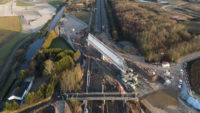The operation was expected to take up to 16 hours; it took 34 hours. The jacks could pull up to 10 ft per hour, but manual adjustments on the bridge delayed the slide. The initial concern was starting the move, so the jacks were upsized to provide double the pulling power—roughly 10% of the bridge's mass—to overcome friction. "One of the toughest parts is that first friction, because the bridge has been sitting there for the better part of a year," said Nedim Alca, vice president and project director for truss and slide designer Buckland & Taylor Ltd.
As the slide progressed, wind, not friction, was a bigger problem. Deck-level gusts heading from the west at 15 mph pushed against the downstream side of the truss, slackening the strands. "We had done such a good job of polishing the steel—and with the grease very slippery—the wind basically started to overcome friction," Alca said. On April 9, crews locked off the bridge about 16 ft from its starting position and installed additional restraints. The next day went faster, and the slide wrapped up at 6:30 p.m.
The design-build team envisioned the slide as a way to cut down on long-term traffic delays, but the project is still more than a year behind schedule. The contractor lost 250 work days due to high water conditions, Gannon said, and other glitches have slowed down the project. For example, Walsh had to postpone, last month, the slide to refurbish a disc bearing that suddenly dislodged, the cause of which is still under investigation. The team's original contract included just 10 days of closures; they now are expected to creep up to 39 days. At a cost of $25,000 per day, liquidated damages on the project are expected to total $725,000.
The owners still call the unconventional project, the total costs of which are $27 million lower than their original estimates, a success. "Initially, we were delayed by flooding in the spring of 2011. We had some difficulties with the demolition of the old truss, and we have had some issues with preparations for the slide," said Kevin Hetrick, INDOT project manager. "It's definitely behind schedule, but, fortunately, the bridge has stayed open to traffic most of the time."
This article was corrected on April 22, 2014, to reflect that winds came from the west, not heading west as originally stated.







Post a comment to this article
Report Abusive Comment